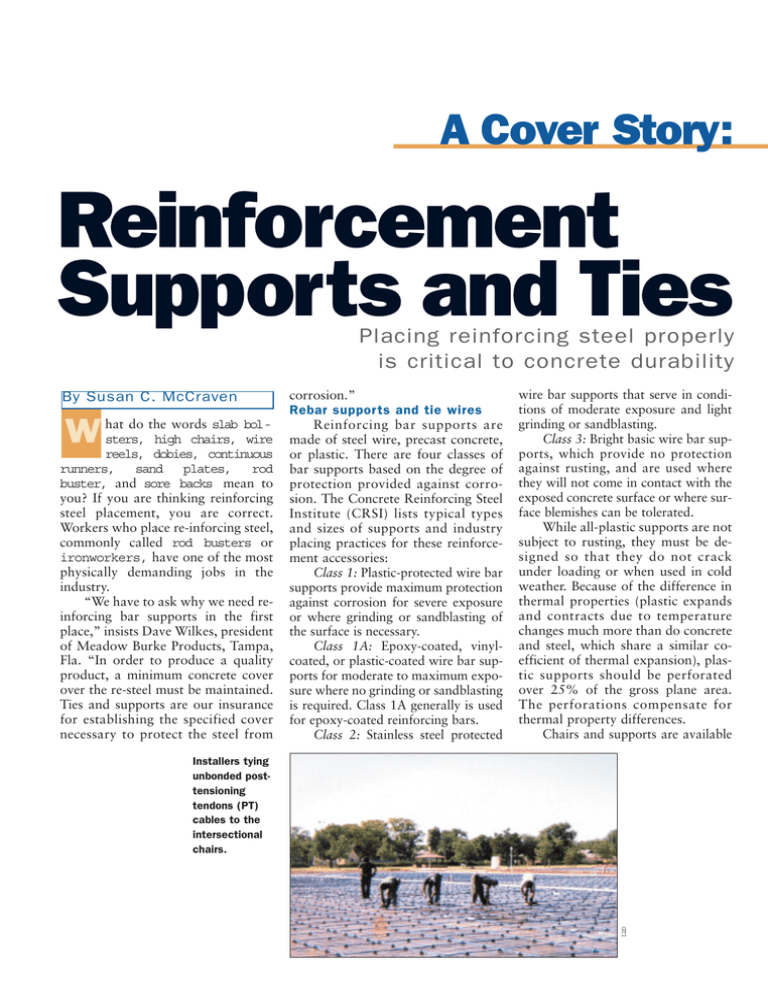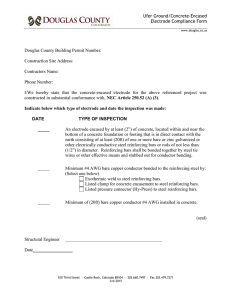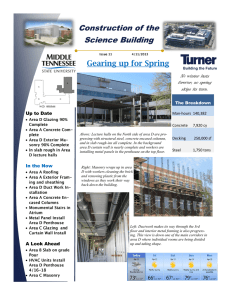
A Cover Story:
Reinforcement
Supports and Ties
Placing reinforcing steel properly
is critical to concrete durability
By Susan C. McCraven
W
hat do the words slab bolsters, high chairs, wire
reels, dobies, continuous
runners, sand plates, rod
buster, and sore backs mean to
you? If you are thinking reinforcing
steel placement, you are correct.
Workers who place re-inforcing steel,
commonly called rod busters or
ironworkers, have one of the most
physically demanding jobs in the
industry.
“We have to ask why we need reinforcing bar supports in the first
place,” insists Dave Wilkes, president
of Meadow Burke Products, Tampa,
Fla. “In order to produce a quality
product, a minimum concrete cover
over the re-steel must be maintained.
Ties and supports are our insurance
for establishing the specified cover
necessary to protect the steel from
corrosion.”
Rebar suppor ts and tie wires
Reinforcing bar supports are
made of steel wire, precast concrete,
or plastic. There are four classes of
bar supports based on the degree of
protection provided against corrosion. The Concrete Reinforcing Steel
Institute (CRSI) lists typical types
and sizes of supports and industry
placing practices for these reinforcement accessories:
Class 1: Plastic-protected wire bar
supports provide maximum protection
against corrosion for severe exposure
or where grinding or sandblasting of
the surface is necessary.
Class 1A: Epoxy-coated, vinylcoated, or plastic-coated wire bar supports for moderate to maximum exposure where no grinding or sandblasting
is required. Class 1A generally is used
for epoxy-coated reinforcing bars.
Class 2: Stainless steel protected
wire bar supports that serve in conditions of moderate exposure and light
grinding or sandblasting.
Class 3: Bright basic wire bar supports, which provide no protection
against rusting, and are used where
they will not come in contact with the
exposed concrete surface or where surface blemishes can be tolerated.
While all-plastic supports are not
subject to rusting, they must be designed so that they do not crack
under loading or when used in cold
weather. Because of the difference in
thermal properties (plastic expands
and contracts due to temperature
changes much more than do concrete
and steel, which share a similar coefficient of thermal expansion), plastic supports should be perforated
over 25% of the gross plane area.
The perforations compensate for
thermal property differences.
Chairs and supports are available
Installers tying
unbonded posttensioning
tendons (PT)
cables to the
intersectional
chairs.
GTI
G O PA ENTERPRISES
This “TiChair” device
locks rebar and posttensioning cable into
position directly at
the intersection, eliminating all wire tying.
The lightweight nylon
is noncorrosive, has
rounded edges for
safety, and is colorcoded for size.
Tie types vary according to
the situation.
Det. A is a snap or single tie;
Det. B is a wrap and snap tie;
Det. C is a saddle or “U” tie;
Det. D is a wrap and saddle
tie; and Det. E is a figureeight tie.
CONCRETE REINFORCING STEEL INSTITUTE
Rebar tying
machines are uniquely designed to
replace the manual
process of tying
rebar. They can save
time and money
while eliminating the
backbreaking nature
of tying rebar.
U-TIER
Rod busters have
to bend constantly
on the job to
install reinforcement and ties. This
work on Highway
401 in Ajax,
Ontario, is physically demanding.
in various heights (usually 1⁄4 inch) to
support specific reinforcing bar size,
and prices vary for each category and
material. Supports also are used to
support post tensioning cables in the
dropped position. In general, plastic
accessories are less expensive than
metal supports, and prices will vary
depending upon the quantity, region,
and supplier. For example, the price
for 100 Class 3, bright basic wire 2inch-high chair with plate is $125. For
100 2-inch-high plastic high chairs
with base the price is about $20.
To meet the specification for
concrete cover, it is not enough to
simply place the bars on supports.
Reinforcing steel must be secured to
prevent displacement during construction activities and concrete
placement. Although equipment can
vary from region to region in the
country, tie wire is usually available
in 3- to 4-pound coils. Wires are
placed in a wire holder or a reel is
suspended from the rod buster’s belt
for accessibility. The wire is typically 161⁄2 - or 16-gauge black, soft, annealed wire.
More heavily reinforced structures require 15- or 14-gauge wire to
hold the proper position of the rebar.
A variety of tie types (ties are basically wire twists for connecting intersecting bars), from snap or single ties
to saddle ties, is used in the concrete
reinforcing industry. The CRSI book
Placing Reinforcing Bars illustrates the types of ties and describes
the circumstances where each is commonly used (see figure).
Standard practice
CRSI writes the rules for acceptable standard practice in the reinforcing steel industry. CRSI’s
Manual of Standard Practice, or
MSP-1, is referenced by the ACI 318
Building Code Requirements. CRSI’s
Placing Reinforcing Bars is the
rod buster’s indispensable handbook.
CRSI publications provide drawings showing the proper placement
of supports and ties, but structural
drawings usually indicate only the
specified concrete cover. The reinforcing steel subcontractor is
responsible for proper installation of
supports and ties. As an example, the
table on page 43 is typical of what
Typical reinforcing steel cover specification
Reinforcing steel shall have protection as follows:
Use
Beam and column bars and
tied shear wall boundary zones
Slab bars
Wall bars: interior faces
exposed to earth or weather
Cover
11⁄2" (to stirrup or ties)
1"
3
⁄4"
11⁄2" (#5 and smaller)
2" (#6 and larger)
3"
Footing bars
Concrete wall reinforcing (unless otherwise noted):
Wall Thickness
6"
8"
10"
Horizontal Bars
#4 @ 16" o.c.
#4 @ 12" o.c.
#4 @ 18" o.c.
Vertical Bars
#4 @ 16" o.c.
#4 @ 16" o.c.
#4 @ 18" o.c.
12"
#4 @ 16" o.c.
#4 @ 16" o.c.
the reinforcing steel installation contractor would get in a specification
for reinforced concrete construction.
Industry rules for proper installation of reinforcing steel are found
in CRSI’s MSP. Here are some things
to remember:
1. Epoxy-coated reinforcing bars
and supports must be coated entirely
with a dielectric material, such as
epoxy or plastic.
2. Bar supports are not intended
as support for construction equipment such as concrete pumps or buggies.
3. Spacing of bar supports depends
upon the size and placing of the reinforcing bar being supported. For example, for a one-way solid slab, with #5
temperature-shrinkage bars, high chairs
are used at 4 feet on center; for #4 bars,
high chairs would be placed 3 feet on
center to prevent sagging.
4. Highway bridgework may
require more stringent specifications
for supports and ties depending upon
the transportation authority that has
jurisdiction. (See comments under
“New technology and trends.”)
5. Concrete cover tolerance cannot exceed minus one-third of the
minimum cover required on the project drawings or specifications.
6. Placing reinforcement onto
layers of fresh concrete or adjusting
the position of bars or welded wire
Location
@ CL of wall
@ CL of wall
cover distance
from each face
cover distance
from each face
fabric during concrete placement
should not be permitted. (The illadvised practice in slab construction
of placing reinforcement on the subgrade and pulling it up during concrete placement is called “hooking.”)
7. Spacers for vertical concrete
(wall construction) have traditionally
been optional. Side form spacers
include wire bar supports, doubleheaded nails, precast concrete blocks
(dobies), and proprietary all-plastic
shapes.
8. The ironworker foreman and
the inspector should check structural
drawings for bar placements, hooks,
and required concrete cover, and discuss any questions with the engineer.
9. Incorrect reinforcing steel placement practice could lead to serious concrete structural failure. For example,
lowering the top bars or raising the bottom bars by 1⁄ 2 inch more than that specified in a 6-inch deep slab could reduce
its load carrying capacity by 20%.
10. It is not necessary to tie bars at
every intersection. Tying adds nothing
to the strength of the finished structure. The purpose of tying is to maintain the bars in proper position during
construction and maintain the required concrete cover; beyond that,
additional tying is unnecessary.
11. “Tack” welding, or field welding, of crossing bars should be avoided. All welding should conform to
ANSI/AWS D1.4, “Structural Welding
Code—Reinforcing Steel.”
12. The ironworker, ironworker
foreman, contractor, and inspector all
have the responsibility to see that the
reinforcing bars in concrete construction are placed properly.
The federal government regulates
safety on the jobsite. OSHA regulations
have been a blessing for worker safety
but often a curse for construction
schedules. Jeff Larson, field superintendent of Steel Engineers, Las Vegas, says,
“The OSHA regulations for hoisting flyover zones have been particularly problematic. In high-rise construction here in
Nevada and elsewhere, keeping all
workers out from under the crane hoisting flyover zone is very difficult to
enforce.” On the other hand, Bill
Livingston, president of Quality ReSteel, Brighton, Mich., remembers the
days of no OSHA regulations in the
early 1960s. “In particular, the OSHA
regulations for barrier rails around
openings in construction have been a
good change. We cover OSHA and
proper safety methods at our industry training programs held annually
in San Diego.” Livingston explains,
“There will always be pros and cons
when it comes to OSHA regulations,
but job safety must be a priority.”
New technology and trends
Probably the newest tool to hit the
rebar placing profession is the tie gun.
According to Gary Miledi, president of
U-Tier Co., Dallas, “Our product retails
for about $1985. In the past there were
problems with maintenance of the tying
gun. The machines have been completely
redesigned and re-engineered and are
now very durable. We will provide trial
equipment to installers who would like
to assess the newer models.” U-Tier
claims that the wire gun is less physically
demanding for the installer, wastes less
material (wire), provides correct twisting
mechanics, and saves time on the job.
Larson, however, disagrees with the
time savings claim, saying, “Our rod
busters typically go through 2 to 21⁄ 2
rolls of wire per day; with 300 feet of
wire on a roll, it’s hard to see how the
gun can beat our production.” U-Tier
would counter that much of the reel wire
is wasted in material that is cut off.
Plastics are growing as the material
of choice for bar supports. Joe Harrison,
structural engineer and vice president
for marketing of General Technologies
Inc. (GTI), Stafford, Texas, says, “Plastics rapidly are becoming the bar support of choice. I would estimate that
about 50% of the bar supports used in
our area are plastic.” With over 20 years
of experience in the re-steel accessory
business, Harrison comments on what
he sees as the major trends: “We are
seeing greater acceptance of plastic or
composite bar supports across the country. Twenty years ago bar supports were
predominantly metal. As a result of corrosion problems and staining of concrete, plastic protected metal bar supports were developed. Ultimately, plastic
bar supports were developed as an alternate to a thin, plastic coating over metal.
There are still regions where metal bar
supports are the material of choice;
however, an increasing number of DOTs
are converting to plastic accessories.”
Plastic supports can equal or exceed
the strength of traditional concrete
dobies. GTI’s composite bar chair has
been shown to support loads exceeding
2000 pounds. Tilt-up and precast panels
typically use all-plastic supports.
Reinforced concrete project drawings are not simple to decipher, and specifications are getting even more specific.
According to Livingston, “Rebar drawings are not easy to read. We teach
apprentice rod busters how to interpret
drawings and install the steel correctly.”
Larson said there is a growing requirement for additional testing of supports:
“More often today, we find that dobies,
or concrete block supports, must be certified for compressive strength.” Livingston and Larson agree that installation
requirements for highway work are
much more stringent. Larson stated that,
“Nevada’s DOT requires that bars
placed more than 1 foot on center be
tied at every intersection, or 100%. Bar
spacing less than 1 foot on center
must be tied at 50%.” Michigan’s
DOT is also more stringent than
CRSI, notes Livingston: “MDOT
requires that all top steel be tied at
100%, or at every intersection, and that
all bottom steel be tied at 50%. And you
never can get the DOT engineers to tell
you why this is necessary.”
The toughest trade?
Everyone agreed that rod busting is
the toughest trade in construction today.
“Rod busters must carry hot reinforcing
bars on their shoulders in the summer
and freezing bars in the winter,” said
Livingston’s son, Kevin, who already has
typical rod-busting backaches even as a
young man. “Unlike other construction trades, there is no downtime for
the rod buster. Guys work straight
through without stopping except for
mandatory breaks, and they bend over
constantly to place and tie steel.”
“We usually work without the advantage of cranes to lift the bars, as is
the case for structural steel and ironworkers,” says Bill Livingston. Back
problems are endemic in this trade,
and shoulder burns from hoisting hot
steel bars are not uncommon.
The reinforcing steel installation
trade shares the serious shortage of
trained workers presently experienced
by the concrete construction industry as
a whole. “Finding and keeping skilled
rod busters is no easy task. In our efforts
to find and keep workers, our ironworker local has agreed to establish
higher incoming pay scales for apprentice rod busters if they agree to stay in the
trade for a minimum period,” said
Livingston. Given the opportunity,
most rod busters will move on to less
physically punishing construction trades.
Look for the “New Generation
of Reinforcing,” covering nonsteel reinforcement in the September issue of
CONCRETE CONSTRUCTION. ■
References
1. ACI 117, “Standard Specifications for
Tolerances for Concrete Construction
and Materials and Commentary,”
American Concrete Institute,
Farmington Hills, Mich.
2. ACI 318, “Building Code Requirements
for Structural Concrete,” American
Concrete Institute, Farmington Hills, Mich.
3. Manual of Standard Practice, MSP1, Concrete Reinforcing Steel Institute,
Schaumburg, Ill.
4. Placing Reinforcing Steel,
Concrete Reinforcing Steel Institute,
Schaumburg, Ill.
Suppliers of reinforcement supports
and ties
Aztec Concrete Accessories;
877-531-3344; fax: 909.355.8649;
www.azteconline.com
Clip-Con Re-Bar Fasteners & Supplies;
800-634-7301; fax: 408.436.9694;
www.clip-con.com
Empire Specialty Steel;
716-366-1000; fax: 716.366.0478;
www.empirespecialtysteel.com
General Technologies Inc.; 888-255-0440;
fax: 281.240.0990; www.gti-usa.net
Gopa Enterprises; 800-767-9926; fax:
408.436.9694
Mar-Mac Wire; 843-335-5000; fax:
843.335.5100; www.marmacwire.com
Meadow Burke Products;
813-248-1944; fax: 813.248.0703;
www.meadowburke.com
U-Tier Co, Ltd.; 214-358-3500; fax:
214.358.3630; www.u-tier.net
Publication #C01H041
Copyright © 2001 Hanley-Wood, LLC
All rights reserved




